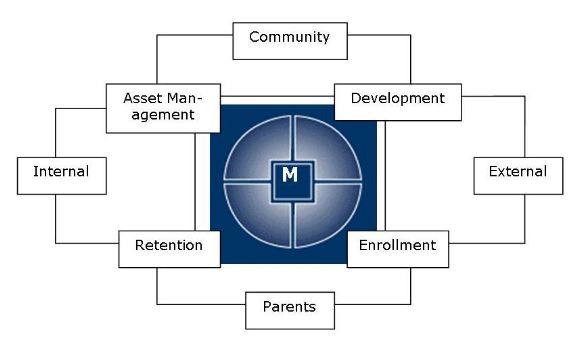Remember when you were in Algebra class, and the teacher introduced you to “Graphing the equation of a line?” Not only was it bad enough to remember things like slope-intercept form or point-slope form, you had to draw all those Cartesian Coordinate Systems – little graphs (if you didn’t use graph paper) in order to plot two points somewhere in the four quadrants so that they can be connected by a line.
The middle of that system, point (0,0), was know as the origin.
The same can be said of marketing. Actually, there are two concepts that show how the five elements of advancement (development, enrollment, retention, asset management and marketing) are related. The first is cyclical. In this model, marketing is where all advancement starts. Marketing causes parents to be interested in enrolling their child; enrollment leads to the hope to continue to attend the school (retention); in order for retention to occur, perhaps some financial aid, or a way to manage the tuition a parent has to pay (asset management); and to provide assets to the school, development creates and strengthens relationships of individuals and businesses engaged in the mission of the school. The only way that more individuals can become engaged is to continue to tell the story of the school (marketing) – and the cycle continues.
The second shows marketing as communication – and how communication must occur with the four other aspects of advancement. From the following diagram, one can see that marketing is at the center – the “heart” of the matter, if you will. (Thanks to Teeter Associates, Inc. in Greensburg for use of their logo to demonstrate these relationships. Contact them at http://www.teeterassociates.com.)
Constituencies must “market” to achieve communication with the four quadrants (the remaining aspects of the advancement model): Enrollment (external students/parents), Retention (internal students/parents), Asset Management (internal constituencies/organizations) and Development (external constituencies/organizations). Each constituency (parents and community) have a different manner in which information must be communicated. Further, each of these groups has an internal and external component. Internal and external constituencies also must be communicated with differently.
For instance, you wouldn’t send the same letter to a prospective parent to get them to come to a school event as you would send to a current school parent. Taking this same event, you wouldn’t send either of those letters to community members or to pastors and parishioners. Each constituency should receive its own personalized invitation, customized to each of their particular interests.
It’s a lot of work, but the results of such customization will be most beneficial in the long run…and the long view is the one development (as well as advancement) takes.
© Michael V. Ziemski, SchoolAdvancement, 2007

